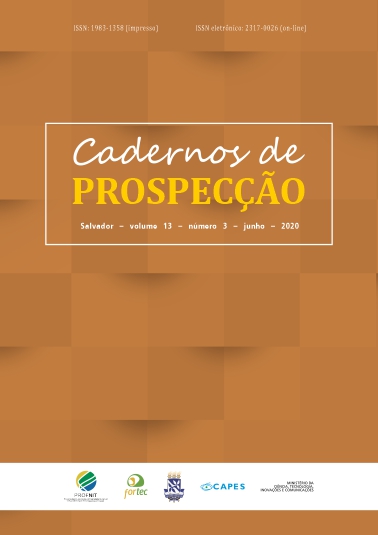Perspectiva de Uso da Inteligência Artificial (IA) para a Eficiência Energética em Prédios Públicos
DOI:
https://doi.org/10.9771/cp.v13i3.33079Palavras-chave:
Aprendizado de Máquina, Automação, Edificações Públicas.Resumo
Este trabalho realizou o levantamento do uso de Inteligência Artificial (IA) para a gestão de eficiência energética em prédios públicos. Utilizou-se da abordagem qualitativa, com objetivo exploratório sobre o tema em questão, apoiando-se na pesquisa bibliográfica, em bases de publicações científicas e documental, em órgãos do governo brasileiro sobre eficiência energética e prospecção tecnológica. As palavras-chave utilizadas foram “artificial intelligence AND energy efficiency AND public buildings”, a busca na Scopus retornou 1.459 artigos referentes ao objeto deste trabalho. A maioria dos documentos por afiliações pertence a instituições de ensino chinesas e europeias, embora tenha se notado que Estados Unidos ocupa a primeira posição em número de publicações por país. Quanto à prospecção tecnológica, a maioria das patentes pertence, também, a universidades, mas, neste caso, a China se destaca. Como Inteligência Artificial é um termo abrangente, isso possibilita o desenvolvimento de trabalhos futuros com maior aprofundamento em um ramo específico da IA.
Downloads
Referências
BRASIL. Lei n. 10. 295, de 17 de outubro de 2001. Dispõe sobre a Política Nacional de Conservação e Uso Racional de Energia e dá outras providências. 2001.
CASARIN, H. D. C. S.; CASARIN, S. J. Pesquisa Cientifica: da teoria à pratica. 1. ed. Curitiba: Intersaberes, 2012.
DA SILVA, J. L. Controle eficiente com ferramentas de inteligência artificial em um sistema de exaustão. Recife: Universidade Federal de Pernambuco, 2017.
EPE - EMPRESA DE PESQUISA ELÉTRICA. Figura 1. 2017.
FLORÊNCIO, M. N. DA S. et al. Prospecção Tecnológica: um estudo sobre os depósitos de patentes em nanobiotecnologia. Cadernos de Prospecção, Salvador, v. 10, n. 2, p. 315-326, 2017.
GOMES, D. D. S. Inteligência Artificial: Conceitos e Aplicações. Olhar Científico, [S.l], v. 1, n. 2, p. 234-246, 2011.
GUL, M. S.; PATIDAR, S. Understanding the energy consumption and occupancy of a multi-purpose academic building. Energy and Buildings, [S.l], v. 87, p. 155-165, 2015.
HENRÍQUEZ, M. R.; PALMA, P. A. Automatic Control of Environmental Conditions in Domotics using Artificial Neural Networks. Información tecnológica, [S.l], v. 22, n. 3, p. 125-139, 2011.
JACOBSEN, B. 5 Countries Leading the Way in AI. [2018]. Disponível em: https://www.futuresplatform.com/blog/5-countries-leading-way-ai-artificial-intelligence-machine-learning. Acesso em: 7 out. 2019.
KESWANI, G. G. Artificial Intelligence- Is Our Future Bright or Bleak. International Journal of Engineering and Advanced Technology, [S.l], v. 2, n. 4, p. 348, 2013.
LI, S. L.; DONG, Y. G.; WANG, L. Z. Fuzzy Inference Algorithm based on Quantitative Association Rules. Procedia Computer Science, Complex Adaptive Systems San Jose, CA November 2-4, v. 61, p. 388–394, 2015.
MAKRIDAKIS, S. The forthcoming Artificial Intelligence (AI) revolution: Its impact on society and firms. Futures, [S.l], v. 90, p. 46-60, 2017.
MILLER, H. et al. Government AI Readiness Index 2019. London, England: Oxford Insights, 2019. Disponível em: https://www.oxfordinsights.com/ai-readiness2019. Acesso em: 7 out. 2019.
MORENO, M. V. et al. Big data: the key to energy efficiency in smart buildings. Soft Computing, [S.l], v. 20, n. 5, p. 1.749-1.762, 2016.
NASCIMENTO, R. L. Política de eficiência energética no Brasil. Brasília: Consultoria Legislativa da Camara dos Deputados, 2015.
POOLA, I. How Artificial Intelligence in Impacting Real life Everyday. International Journal of Advance Research and Development, [S.l], v. 2, n. 10, p. 96, 2017.
PROCELINFO. Resultados PROCEL 2018, ano base 2017. Rio de Janeiro: Programa Nacional de Conservação de Energia Elétrica. 2018. Disponível em: http://www.procelinfo.com.br/resultadosprocel2018/. Acesso em: 25 maio 2019.
SEBRAE. Sustentabilidade nos pequenos negócios: Eficiência Energética. 2. ed. Cuiabá: Instituto Envolverde; Sebrae, 2015.
SOARES, B. et al. Um Sistema para Gerenciamento Automático e Eficiência Energética em Prédios Inteligentes. Dimap, [S.l], p. 10, 2017.
TSANAS, A.; XIFARA, A. Accurate quantitative estimation of energy performance of residential buildings using statistical machine learning tools. Energy and Buildings, [S.l.], v. 49, p. 560-567, 2012.
TSE, E. Inside China’s quest to become the global leader in AI. Jornal. [2017]. Disponível em: https://www.washingtonpost.com/news/theworldpost/wp/2017/10/19/inside-chinas-quest-to-become-the-global-leader-in-ai/?noredirect=on. Acesso em: 7 out. 2019.
WĘGLARZ, A. Using Artificial Intelligence in energy efficient construction. E3S Web of Conferences, [S.l], v. 49, p. 9, 2018.
WORLD ENERGY COUNCIL. World Energy Issues Monitor 2019. London: WEC, 2019. Disponível em: http://www.worldenergy.org. Acesso em: 26 maio. 2019.
Downloads
Publicado
Como Citar
Edição
Seção
Licença
Copyright (c) 2020 Cadernos de Prospecção

Este trabalho está licenciado sob uma licença Creative Commons Attribution-NonCommercial 4.0 International License.
O autor declara que: - Todos os autores foram nomeados. - Está submetendo o manuscrito com o consentimento dos outros autores. - Caso o trabalho submetido tiver sido contratado por algum empregador, tem o consentimento do referido empregador. - Os autores estão cientes de que é condição de publicação que os manuscritos submetidos a esta revista não tenham sido publicados anteriormente e não sejam submetidos ou publicados simultaneamente em outro periódico sem prévia autorização do Conselho Editorial. - Os autores concordam que o seu artigo ou parte dele possa ser distribuído e/ou reproduzido por qualquer forma, incluindo traduções, desde que sejam citados de modo completo esta revista e os autores do manuscrito. - Revista Cadernos de Prospecção está licenciado com uma Licença Creative Commons Attribution 4.0. Esta licença permite que outros remixem, adaptem e criem a partir do seu trabalho para fins não comerciais, e embora os novos trabalhos tenham de lhe atribuir o devido crédito e não possam ser usados para fins comerciais, os usuários não têm de licenciar esses trabalhos derivados sob os mesmos termos.
Este obra está licenciado com uma Licença Creative Commons Atribuição 4.0 Internacional.








